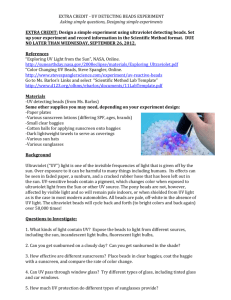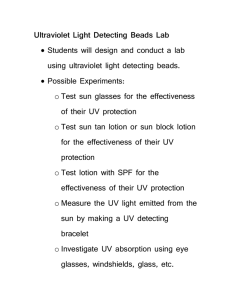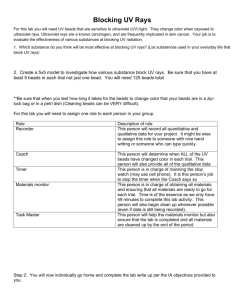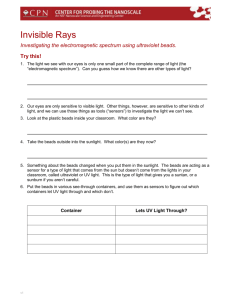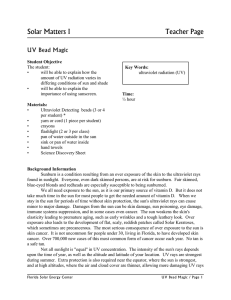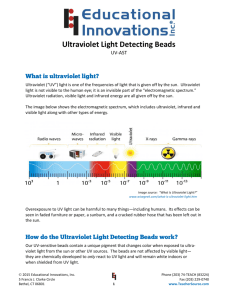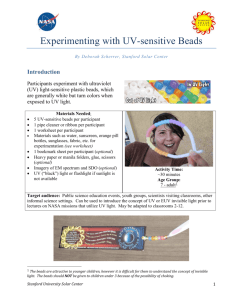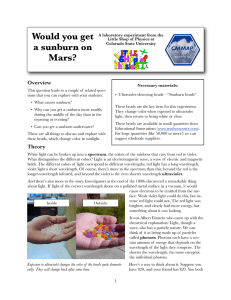UV bead lab
advertisement
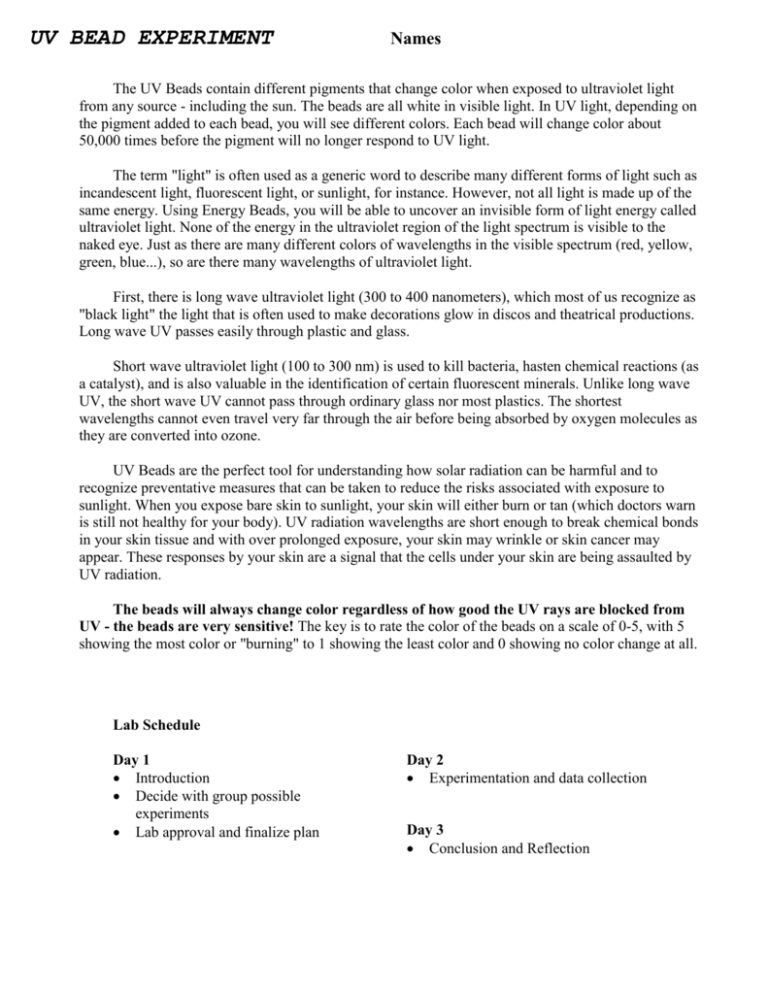
UV BEAD EXPERIMENT Names The UV Beads contain different pigments that change color when exposed to ultraviolet light from any source - including the sun. The beads are all white in visible light. In UV light, depending on the pigment added to each bead, you will see different colors. Each bead will change color about 50,000 times before the pigment will no longer respond to UV light. The term "light" is often used as a generic word to describe many different forms of light such as incandescent light, fluorescent light, or sunlight, for instance. However, not all light is made up of the same energy. Using Energy Beads, you will be able to uncover an invisible form of light energy called ultraviolet light. None of the energy in the ultraviolet region of the light spectrum is visible to the naked eye. Just as there are many different colors of wavelengths in the visible spectrum (red, yellow, green, blue...), so are there many wavelengths of ultraviolet light. First, there is long wave ultraviolet light (300 to 400 nanometers), which most of us recognize as "black light" the light that is often used to make decorations glow in discos and theatrical productions. Long wave UV passes easily through plastic and glass. Short wave ultraviolet light (100 to 300 nm) is used to kill bacteria, hasten chemical reactions (as a catalyst), and is also valuable in the identification of certain fluorescent minerals. Unlike long wave UV, the short wave UV cannot pass through ordinary glass nor most plastics. The shortest wavelengths cannot even travel very far through the air before being absorbed by oxygen molecules as they are converted into ozone. UV Beads are the perfect tool for understanding how solar radiation can be harmful and to recognize preventative measures that can be taken to reduce the risks associated with exposure to sunlight. When you expose bare skin to sunlight, your skin will either burn or tan (which doctors warn is still not healthy for your body). UV radiation wavelengths are short enough to break chemical bonds in your skin tissue and with over prolonged exposure, your skin may wrinkle or skin cancer may appear. These responses by your skin are a signal that the cells under your skin are being assaulted by UV radiation. The beads will always change color regardless of how good the UV rays are blocked from UV - the beads are very sensitive! The key is to rate the color of the beads on a scale of 0-5, with 5 showing the most color or "burning" to 1 showing the least color and 0 showing no color change at all. Lab Schedule Day 1 Introduction Decide with group possible experiments Lab approval and finalize plan Day 2 Experimentation and data collection Day 3 Conclusion and Reflection UV Beads Experiment ***No personal words (I, we, you…) Title /30 pts (1pt) What is the name of your lab? Problem? State the problem as a question. Be specific about what you are testing! Make sure you end with a question mark. (2pts) Hypothesis (2pts) Materials (3pts) Variables (4pts) Procedure (3pts) Data (4pts) Graph (4pts) Conclusion (4 pts) Reflection (3pts) What is the answer to the problem/ question? Start with “If (restate the problem), then (prediction)....” What “stuff” are you using? List materials and equipment used in the lab. Be sure to say what kind and how many. What is your independent variable? What is your dependent variable? Name at least 2 variables you are controlling (controls). What are you doing? List the steps you will follow to do the experiment. Be clear and specific. Number your steps. Make sure you use a reference (control group) in your experiment. Data Table including: Bead scale numbers Observations: What variables might have affected your experiment? Graph including: Descriptive title/ axis labels Clear visual of data Based on your observations, what is the answer to the problem stated above? Why do you think things happened the way they did? Try to explain your results; do not merely restate your observations. Was your hypothesis correct? Why or why not? What future experiments might you do to better answer your question? How do these results affect everyday life (Be specific about What your results can tell people)? ****************************************************************** All parts must be in complete sentences except for Data, Materials list, and Procedure! Name(s): Dates: Period: Title: ______________________________________________________ Question: _______________________________________________________________ _______________________________________________________________ Hypothesis: _______________________________________________________________ _______________________________________________________________ Materials: o o o o o o Experiment: Independent Variable (what you are physically changing): ____________________ Dependent Variable (what changes because of the physical change): Procedure: 1. 2. 3. 4. 5. 6. 7. 8. 9. 10. ______________ Observations (What do you see happening?): Data Table: Insert a table to organize your data Graph: Create a bar graph for your data and insert it into this document Conclusion (see rubric for what to write): __________________________________________________________ _______________________________________________________________ _______________________________________________________________ _______________________________________________________________ _______________________________________________________________ _______________________________________________________________ _______________________________________________________________ _______________________________________________________________ _______________________________________________________________ _______________________________________________________________ __________________________________________________________ _______________________________________________________________ _______________________________________________________________ _______________________________________________________________ _______________________________________________________________ _______________________________________________________________ _______________________________________________________________ _______________________________________________________________ _____________________________________________________________ Reflection(see rubric for what to write): __________________________________________________________ _______________________________________________________________ _______________________________________________________________ _______________________________________________________________ _______________________________________________________________ _______________________________________________________________ _______________________________________________________________ _______________________________________________________________ _______________________________________________________________ _______________________________________________________________ _______________________________________________________________ __________________________________________________________ _______________________________________________________________ _______________________________________________________________ _______________________________________________________________ _______________________________________________________________ _______________________________________________________________ _______________________________________________________________ _______________________________________________________________ _______________________________________________________________ _______________________________________________________________ _______________________________________________________________ __________________________________________________________
